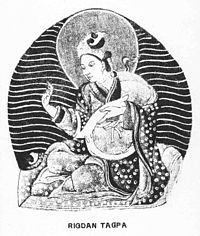- Manjushrikirti
-
Part of a series on Tibetan Buddhism
History Timeline · Related-topics Schools Nyingma · Kagyu · Sakya · Gelug · Bön · Jonang Key concepts Three marks of existence · Skandha · Cosmology · Saṃsāra · Rebirth · Bodhisattva · Dharma · Dependent origination · Karma Major figures Gautama Buddha · Padmasambhava · Je Tsongkhapa · Dalai Lama · Panchen Lama · Lama · Karmapa Lama · Rinpoche · Geshe · Terton · Tulku Buddhahood · Avalokiteśvara · Four stages of enlightenment · Tantric yoga · Paramitas · Meditation · Laity Changzhug · Drepung · Dzogchen · Ganden · Jokhang · Kumbum · Labrang · Mindroling · Namgyal · Narthang · Nechung · Pabonka · Palcho · Ralung · Ramoche · Sakya · Sanga · Sera · Shalu · Tashilhunpo · Tsurphu · Yerpa Chotrul Duchen · Dajyur · Losar · Monlam · Sho Dun Texts Kangyur · Tengyur · Tibetan canon · Mahayana sutras · Nyingma Gyubum Sand mandala · Thangka · Ashtamangala · Tree of physiology Outline · Comparative studies · Culture · List of topics · Portal
 Rigden Trakpa or Manjushríkírti, King of Shambhala
Rigden Trakpa or Manjushríkírti, King of Shambhala
Manjushrikirti or Manjughoshikirti (Skt. Mañjuśrīkīrti; Chinese: 妙吉祥稱; pinyin: Miàojíxiángchēng; Wylie: Jam-dpal Grags-pa, ZYPY: Qambai Chagba). Manjushrikirti is said to have been the eighth king of Shambhala and is considered to be the second incarnation in the lineage of the Panchen Lamas of Tibet. As his name indicates, is considered to have been an incarnation of Manjushri, the Bodhisattva of Wisdom.[1]
Manjushrikirti was born in Shambhala, the son of King Deva-Indra and his queen, Kauśikí. His rule is said to have extended over "hundreds of petty kings and a hundred thousand cities." He is said to have expelled 300,510 followers of heretical doctrine of the Mlechhas or "materialistic barbarians", some of whom worshipped the sun, but after reconsidering,[2] he brought them back and they asked for his teachings. Next he united all the castes, or religious factions, of Shambala into one Vajra or 'Diamond' Caste. Consequentially, he was the first king of Shambhala to be given the title Kalki (Tib. Rigden), meaning "Holder of the Castes" or "Wisdom Holder."[3]
He is said Tibetan sources to have taken the throne 674 years after the death of Gautama Buddha. Following the Tibetan sources, which place the parinirvana in 833 BCE, he would have become king of Shambhala in 159 BCE.[4] There is, however, no consensus on the date of the death of the Buddha. Modern scholars have proposed dates of 563, 483, 410 or 400 BCE. These would suggest dates for his accession of 111, 191, 264 or 274 CE respectively.
He then put the Kalachakra teachings in a condensed and simplified form called the "Sri Kalachakra" or "Laghutantra".[5]
This work is also called the Condensed Kālachakra Tantra (bsdus rgyud, laghutantra). It is usual now simply called the Kālachakra Tantra, the original longer version one is no longer extant.[6]
Contents
Lineage of the Panchen Lamas
In the lineage of the Panchen Lamas of Tibet there were considered to be four "Indian" and three Tibetan incarnations of Amitabha Buddha before Khedrup Gelek Pelzang, who is recognised as the 1st Panchen Lama. The lineage starts with Subhuti, and Manjushrikirti is considered the second incarnation.[7][8]
Footnotes
- ^ Bernbaum, Edwin (1989). The Way to Shambhala: A Search for the Mythical Kingdom Beyond the Himalayas, pp. 234, 291. Jeremy P. Tarcher, Inc., Los Angeles. ISBN 0-87477-518-3.
- ^ Das, Sarat Chandra. Contributions on the Religion and History of Tibet (1970), pp. 81-82. Manjushri Publishing House, New Delhi. First published in the Journal of the Asiatic Society of Bengal, Vol. LI (1882).
- ^ Bernbaum, Edwin (1989). The Way to Shambhala: A Search for the Mythical Kingdom Beyond the Himalayas, p. 234. Jeremy P. Tarcher, Inc., Los Angeles. ISBN 0-87477-518-3.
- ^ Das, Sarat Chandra. Contributions on the Religion and History of Tibet (1970), p. 82 and n. 6. Manjushri Publishing House, New Delhi. First published in the Journal of the Asiatic Society of Bengal, Vol. LI (1882).
- ^ International Kalachakra Network
- ^ Tenzin Gyatso, the Fourteenth Dalai Lama. (1999) Kālachakra Tantra Rite of Initiation: For the Stage of Generation. Translated by Jeffry Hopkins. Enlarged edition, pp. 60, 141. Wisdom Publications, Boston. ISBN 0-86171-151-3.
- ^ Stein, R. A. Tibetan Civilization, (1972) p. 84. Stanford University Press, Stanford, California. ISBN 0-8047-0806-1 (cloth); ISBN 0-0847-0901-7.
- ^ Das, Sarat Chandra. Contributions on the Religion and History of Tibet (1970), pp. 81-103. Manjushri Publishing House, New Delhi. First published in the Journal of the Asiatic Society of Bengal, Vol. LI (1882).
See also
External links
Buddhism Categories:- Buddhist mythology
- Tibetan Buddhism
- Panchen Lamas
Wikimedia Foundation. 2010.

